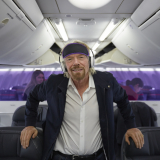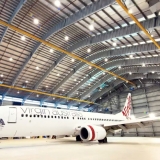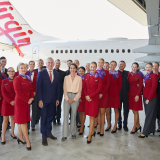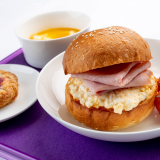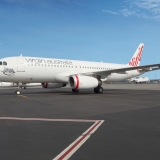Virgin Australia unveils cabin of the future and $110 million fleet-wide aircraft upgrade
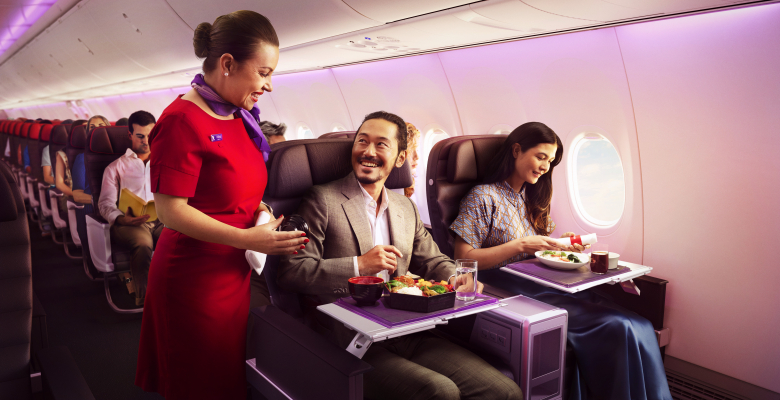
- Thousands of Virgin Australia team members and their families will welcome the airline’s first Boeing 737-8 aircraft at its Brisbane Hangar today.
- Part of the airline’s fleet renewal program, the brand-new, latest generation aircraft, will reduce emissions by at least 15 per cent per flight* supporting the airline’s commitment to targeting net zero emissions by 2050.
- Following research from a two-year prototype study, the airline has unveiled a new cabin interior for its Boeing 737-8 aircraft, featuring up to 50 per cent extra overhead locker space when compared to the airline’s existing Boeing 737 aircraft.
- Virgin Australia’s remaining Boeing 737 fleet will undergo a cabin refurbishment valued at approximately $110 million, featuring new Business Class and Economy seats, in-seat power for all seats, and in-flight Wi-Fi to majority of aircraft.
- Virgin Australia has flown almost 19 million customers domestically in the past 12-months, signalling the highest annual number of domestic passengers carried in the airline's history.
DOWNLOAD VIRGIN AUSTRALIA BOEING 737-8 INTERIOR STILL ASSETS
DOWNLOAD VIRGIN AUSTRALIA BOEING 737-8 INTERIOR VIDEO ASSET
LINK TO VIRGIN AUSTRALIA BOEING 737-8 INTERIOR VIDEO ASSET
Saturday 8 July 2023: More than 3,000 Virgin Australia team members and their families will today celebrate the arrival of the airline’s first fuel-efficient Boeing 737-8* aircraft which touched down on Australian soil last week.
The celebrations, part of a Virgin Australia Family Day at the airline’s Brisbane Hangar, will be hosted by CEO, Jayne Hrdlicka and Boeing’s President of Australia, New Zealand and South Pacific, Maria Fernandez, who will welcome team members from across the Virgin Australia business, many who have flown in from interstate to have a first look at the new aircraft.
Fresh from the Boeing factory in Seattle and featuring that new plane smell, the Boeing 737-8 aircraft marks an exciting new milestone in the transformation of Virgin Australia with its fleet renewal program well underway as the airline continues to work towards its net zero emissions target by 2050. The aircraft is one of 33 fuel-efficient Boeing 737-8 and 737-10 aircraft Virgin Australia has on order, with more fuel-efficient aircraft set to be delivered in the coming months (Refer Notes to Editor).*
With the arrival of the Boeing 737-8, Virgin Australia has also revealed its highly anticipated new Business Class and Economy cabin interior as well as confirming plans to refresh the interior cabins on the airline’s remaining Boeing fleet, as part of an investment of approximately $110 million to improve the flying experience for customers.
Highlight features of the new Boeing 737-8 cabin interior include:
- In-seat power for all Business Class and Economy seats.
- Larger overhead lockers, with capacity to stow up to 50 per cent more carry-on baggage (individual guest carry-on luggage limits will not increase).**
- Wider Business Class seats which also feature leg rests with extendable footrests, storage compartments, tablet/device holders and water bottle holders.
- A new Economy seat design, featuring a ribbed backing to elevate comfort and ergonomics.
- A personal tablet/device holder for all Economy seats, making it easy to view Virgin Australia in-flight entertainment, movies and TV shows.
The interior refresh and product upgrade across Virgin Australia’s remaining Boeing fleet will commence later this year, with the work set to be complete in the next two years, subject to operational requirements. The upgrade includes:
- Installation of in-seat power for all Business Class and Economy seats.
- Installation of new Business Class seats, consistent with the new Boeing 737-8 aircraft.
- Installation of new or refreshed Economy seats, with seat design to be consistent with the new Boeing 737-8 aircraft.
- Introduction of in-flight Wi-Fi and complimentary in-flight entertainment (via a guest’s own personal device) to majority of remaining fleet.
An entirely new seat configuration will also be rolled out through the introduction of a new design cabin divider between Business Class and Economy. The new divider will allow for greater floor space in the Economy cabin and the subsequent installation of between six and 12 additional Economy seats. The refurbishment will also include the replacement of one Economy X row with Economy seating on all Boeing 737-800 aircraft. Once the cabin refresh program is complete, the unified in-flight offering will deliver more seats for travellers and a consistent guest experience across all flights operated by Virgin Australia Boeing 737 aircraft.
Commentary
Virgin Australia Group CEO, Jayne Hrdlicka said she was excited to welcome the Boeing 737-8 aircraft into the fleet.
“It is wonderful to be here celebrating the arrival of our new fuel-efficient aircraft with the wider Virgin Australia family,” said Ms Hrdlicka.
“Our people are the special sauce at Virgin Australia, and we are thrilled to be giving them and their families the first look at this aircraft and its new interior. It is hard not to feel excited and inspired when you are in a hangar with a new aircraft, and maybe today we will inspire the next generation of Virgin Australia employees, with so many of our team members’ kids in the room.
“Today is also an important milestone for Virgin Australia as we grow and renew our fleet and continue investing in our onboard guest experience.
“Sustainability is so important for the future of the airline industry globally and fleet renewal is a major step in reducing carbon emissions intensity,” she said.
“We anticipate our fleet renewal program, together with other fuel efficiency initiatives, will support over 80 per cent of our 2030 interim target to reduce Virgin Australia’s carbon emission intensity by 22 per cent.”
Speaking about the new cabin interiors, Virgin Australia Group Chief Customer and Digital Officer, Paul Jones, said:
“In 2021 we introduced a prototype cabin interior on two Boeing 737-800 aircraft, and over the last couple of years we’ve been able to obtain feedback from our guests, which enables us to enhance our entire Boeing fleet with the features that are most important to them. We’ve always said that we are a business that listens to its customers, and this is a testament to that.
“If you look at the business community, what matters most to them outside of network schedule is in-seat power and in-flight Wi-Fi, so I’m really excited that will feature on the majority of our fleet. There’s also a huge number of customers who fly with us for leisure who value in-seat power for a different reason – powering devices to keep their kids entertained, or streaming and bingeing on the latest must-see shows.
“With the reconfiguration of our cabin interior, we are also able to add more seats to the market without changing the legroom experience, providing Australian travellers with even more choice and great value airfares as well as a consistent in-flight experience,” he said.
President of Boeing Australia, New Zealand and South Pacific, Maria Fernandez said:
“It’s wonderful to see Virgin Australia’s first 737-8 in Brisbane, and I congratulate our entire 737 team on its delivery including Boeing Aerostructures Australia in Melbourne, which produced the rudder, winglets and ailerons.
“This aircraft is incredibly fuel efficient and quiet; it also serves as a symbol of our long and growing partnership with Virgin Australia as we collaborate on sustainability initiatives that are important to both our companies and stakeholders.”
Virgin Australia has undergone an incredibly successful transformation over the past two years, recruiting thousands of new team members, introducing 27 new aircraft (nearly 50 per cent more than November 2020)***, new airline and loyalty partners and millions of new Velocity Frequent Flyer members. The airline has also flown nearly 19 million customers domestically in the past 12-months# – the highest in the airline’s history.
Today’s announcement follows the launch of Virgin Australia’s new Tokyo services – the first time the airline has ever operated flights between Australia and Japan. The new Boeing 737-8 aircraft is scheduled to start flying on this route on 30 July 2023.
ENDS
NOTES TO EDITORS
Virgin Australia will add the following fuel-efficient* Boeing aircraft to its fleet:
- Eight Boeing 737-8 aircraft (one aircraft delivered in June 2023, 7 to be delivered by Q1 2024)
- 25 Boeing 737-10 aircraft (planned delivery from late 2024)
Virgin Australia Boeing 737 seat capacity once cabin refresh is complete:
- Boeing 737-800 and 737-8 aircraft (31 rows, 8 Business Class seats, 174 Economy seats)
- Boeing 737-700 aircraft (23 rows, 8 Business Class seats, 126 Economy seats). This includes the introduction of a Business Class cabin on 7 existing Boeing 737-700 aircraft which are currently fitted with Economy seating only.
FOOT NOTES
* Boeing 737-8 aircraft are at least 15 percent more fuel efficient per flight when compared to the Virgin Australia Boeing 737-800 NG fleet.
**Carry-on luggage limits for each passenger will remain the same. These can be found here.
***Virgin Australia relaunched in November 2020 with 58 aircraft. With the addition of the latest Boeing 737-8, there are now 85 aircraft in the airline’s fleet.
#Virgin Australia carried 17.7 million customers domestically in FY19.

